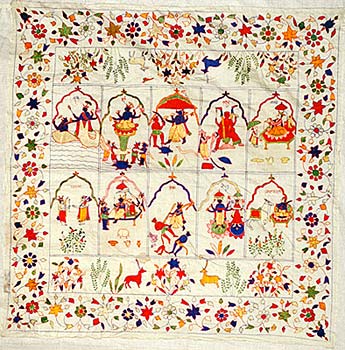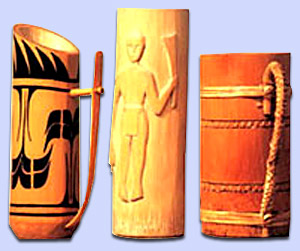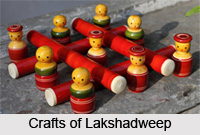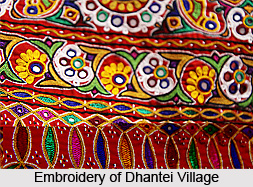Embroidery of Himachal Pradesh is an exquisite form of artistry that is ramified in two broad categories like rumal embroidery and leather embroidery. The rich variations and the traditional craftsmanship of the local artisans have alleviated the craft to a great extent.
 Following the custom, the rumal embroidery is presented during Chamba and Suni weddings and this is an important part of the bride`s trousseau in Himachal Pradesh. This rumal is used differently in case of men and women. The men drape these colourful embroidered rumals over their shoulders and the women use them as flowing veils according to the social custom. The local women of Himachal Pradesh are engaged in the embroidery work. Beautiful pieces like rumals or scarves, coverlets, hand fans, caps, cholis or bodices, gaumukhi or prayer gloves are common in every house of this state as well in the local market. The women choose motifs either from the traditional stock of miniature painting or the landscape. The hilly beauty of the state gets intensity in the needle of the artisans. Often scenes from the Mahabharata, the Ramayana, Raas-lila of Radha and Krishna are depicted with the silk thread on tussar cloth or fine cotton. The ground is usually white or cream, but the embroidery threads (usually red and orange) are used to make a striking contrast in the creations. A finely embroidered rumal can take something like even a month to complete. Sometimes the local women, who are predominantly the creators of these designs, use their innovations along with the traditional embroidery ethics. This craft is mainly practiced by the women of Pahari community.
Following the custom, the rumal embroidery is presented during Chamba and Suni weddings and this is an important part of the bride`s trousseau in Himachal Pradesh. This rumal is used differently in case of men and women. The men drape these colourful embroidered rumals over their shoulders and the women use them as flowing veils according to the social custom. The local women of Himachal Pradesh are engaged in the embroidery work. Beautiful pieces like rumals or scarves, coverlets, hand fans, caps, cholis or bodices, gaumukhi or prayer gloves are common in every house of this state as well in the local market. The women choose motifs either from the traditional stock of miniature painting or the landscape. The hilly beauty of the state gets intensity in the needle of the artisans. Often scenes from the Mahabharata, the Ramayana, Raas-lila of Radha and Krishna are depicted with the silk thread on tussar cloth or fine cotton. The ground is usually white or cream, but the embroidery threads (usually red and orange) are used to make a striking contrast in the creations. A finely embroidered rumal can take something like even a month to complete. Sometimes the local women, who are predominantly the creators of these designs, use their innovations along with the traditional embroidery ethics. This craft is mainly practiced by the women of Pahari community.
Embroidery of Himachal Pradesh has extended widely in the Chamba region and the hill states of Chamba, Kangra, Basholi, and other neighbouring provinces are the abode of deft artisans for embroidery work of Himachal Pradesh. The rumals are used in different ways, from covering gifts to traditional usages among the local people. Among the popular motifs, the Raas mandal and the Krishna motifs are preferred by the local people of this state. The artisans use unbleached muslin cloth for creating these types of rumals and bestow life to the motifs by using a double satin stitch locally called `Do-rookha`. This stitch makes the rumal beautiful artwork to look at from the both side thus enhancing the quality of the embroidery of Himachal Pradesh. Chamba Rumals has an age long tradition that dates back to the mid 18th century and this tradition is being carried on by the local artisans of this state since then. Though the original shape of the rumals is square, rectangular rumals are also available that range from 2 to 6 feet in length. It is also known as `Kashida` in the history embroidery of Himachal Pradesh. Suni embroidery is only one side and chiefly comprises of geometrical patterns.
In the present days, the popularity of these types of rumals has gained the utilitarian status. Keeping in mind the modern fashion, the artisans involved in the embroidery of Himachal Pradesh are incorporating traditional designs. The sizes of these items have adapted to present-day requirements that include napkins, tablecloths, wall decorations and bed sheets. The embroidery of Himachal Pradesh which flourished under the royal patronage originated with the peasant class as far as leather embroidery is concerned.
The rich cultural heritage of the embroidery of Himachal Pradesh has reached to its heights because of the complete dedication and the constant innovation of the artisans.






